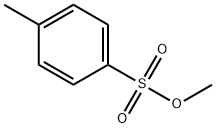white to slightly yellow low melting solid. Soluble in alcohol, ether, benzene, insoluble in water. Hygroscopic.
Methyl p-Toluenesulfonate can be used in the manufacture of dyes and organic synthesis, and also is the raw materials of methylation.
Methyl p-toluenesulfonate is used as a methylating agent in organic synthesis. It acts as a catalyst for alkyd resins. It is also employed in selective 1-substitution reaction of tetrazole. Further, it is used in the preparation of dyes.
Methyl p-toluenesulfonate was synthesized by the reaction of p-toluenesulfonyl chloride with methanol. Mix p-toluenesulfonyl chloride and methanol, slowly add 25% sodium hydroxide solution, control the temperature below 25 °C, stop adding alkali when the pH is 9, continue stirring for 2 hours, and leave overnight. The lower layer of reactant was taken, the upper layer was extracted with benzene, the extract was recovered with benzene and then combined with the lower layer, washed with water and 5% potassium carbonate solution in turn, dried and distilled under reduced pressure to obtain the finished product of methyl p-toluenesulfonate.
Methyl p-toluenesulfonate is sulfonate ester present as potentially genotoxic impurity in drug substances. Kinetics of reactions of methyl p-toluenesulfonate with N,N-dimethylaniline has been investigated. It participates in selective 1-substitution reaction of tetrazole.
Toxic by ingestion and inhalation, strongirritant to skin and eyes.
Poison by ingestion and
subcutaneous routes. An eye and severe skin
irritant. A vesicant and skin sensitizer.
Questionable carcinogen with experimental
tumorigenic data. When heated to
decomposition it emits toxic fumes of SOx.
The ester is purified by distillation in vacuo and could be crystallised from pet ether or Et2O/pet ether at low temperature. It is a powerful methylating agent, is TOXIC andis a skin irritant, so it is better to purify it by repeated distillation. [IR: Schreiber Anal Chem 21 1168 1949, Buehler et al. J Org Chem 2 167 1937, Roos et al. Org Synth Coll Vol I 145 1948, Beilstein 11 IV 247.]



